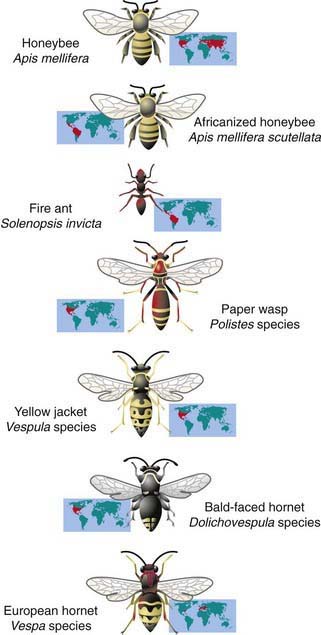Chapter 140 Insect Allergy
Allergic responses to stinging or, more rarely, biting insects vary from localized cutaneous reactions to systemic anaphylaxis. Allergic reactions that are caused by inhalation of airborne particles of insect origin result in acute and chronic respiratory symptoms of seasonal or perennial rhinitis, conjunctivitis, and asthma.
Etiology
Most reactions to biting and stinging insects, such as those induced by mosquitoes, flies, and fleas, are limited to a primary lesion isolated to the area of the bite and do not represent an allergic response. Occasionally, insect bites or stings induce pronounced localized reactions or systemic reactions that may be based on immediate or delayed hypersensitivity reactions. Systemic allergic responses to insects are attributed most typically to immunoglobulin (Ig) E antibody–mediated responses, which are caused primarily by stings from venomous insects of the order Hymenoptera and more rarely from ticks, spiders, scorpions, and Triatoma (kissing bug). Members of the order Hymenoptera include apids (honeybee, bumblebee), vespids (yellow jacket, wasp, hornet), and formicids (fire and harvester ants) (Fig. 140-1). Among winged stinging insects, yellow jackets are the most notorious for stinging because they are aggressive and ground dwelling, and they linger near activities involving food. Hornets nest in trees, whereas wasps build honeycomb nests in dark areas such as under porches; both are aggressive if disturbed. Honeybees are less aggressive, nest in tree hollows, and, unlike the stings of other flying Hymenoptera, honeybee stings almost always leave a barbed stinger with venom sac.

Figure 140-1 Species of Hymenoptera and their geographical distribution.
(From Freeman TM: Hypersensitivity to Hymenoptera stings, N Engl J Med 351:1978–1984, 2004.)
In the USA, fire ants are found increasingly in the Southeast, living in large mounds of soil. When disturbed, the ants attack in large numbers, anchor themselves to the skin by their mandibles, and sting multiple times in a semicircular pattern. Sterile pustules form at the sting sites. Systemic reactions to stinging insects occur in 0.4-0.8% of children and 3% of adults and account for ≈40 deaths each year in the USA.
IgE antibody–mediated allergic responses to airborne particulate matter carrying insect emanations contribute to seasonal and perennial symptoms affecting the upper and lower airways. Seasonal allergy is attributed to exposures to a variety of insects, particularly aquatic insects such as the caddis fly and midge, or lake fly, at a time when larvae pupate and adult flies are airborne. Perennial allergy is attributed to sensitization to insects such as cockroaches and ladybugs as well as house dust mite, which is phylogenetically related to spiders rather than insects and has eight rather than six legs.
Pathogenesis
Localized skin responses to biting insects are caused primarily by vasoactive or irritant materials derived from insect saliva, and rarely occur from IgE-associated responses. Systemic IgE-mediated allergic reactions to salivary proteins of biting insects such as mosquitoes are reported but uncommon.
Hymenoptera venoms contain numerous components with toxic and pharmacologic activity and with allergenic potential. These constituents include: vasoactive substances such as histamine, acetylcholine, and kinins; enzymes such as phospholipase and hyaluronidase; apamin; melittin; and formic acid. The majority of patients who experience systemic reactions after Hymenoptera stings have IgE-mediated sensitivity to antigenic substances in the venom. Some venom allergens are homologous among members of the Hymenoptera order; others are family specific. There is substantial cross reactivity among vespid venoms, but these venom allergies are distinct from honeybee venom allergies.
A variety of proteins derived from insects can become airborne and induce IgE-mediated respiratory responses, causing inhalant allergies. The primary allergen from the caddis fly is a hemocyanin-like protein, and that from the midge fly is derived from hemoglobin. Allergens from the cockroach are the best studied and are derived from cockroach saliva, secretions, fecal material, and debris from skin casts.
Clinical Manifestations
Insect bites are usually urticarial but may be papular or vesicular. Papular urticaria affecting the lower extremities in children is usually caused by multiple bites. Occasionally, individuals have large local reactions. IgE antibody–associated immediate- and late-phase allergic responses to mosquito bites sometimes mimic cellulitis.
Clinical reactions to stinging venomous insects are categorized as local, large local, generalized cutaneous, systemic, toxic, and delayed/late. Simple local reactions
Stay updated, free articles. Join our Telegram channel

Full access? Get Clinical Tree


